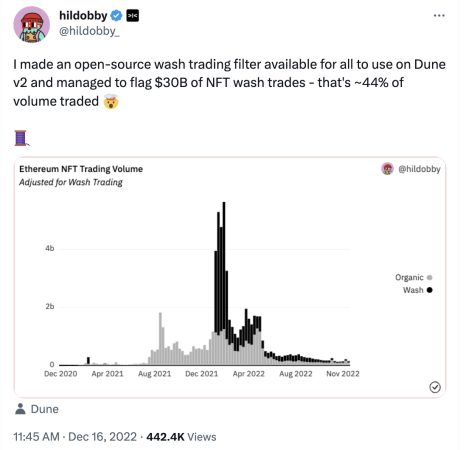NFT
Bitcoin Ordinals, the non-fungible tokens minted on the world’s most valuable blockchain, have been the talk of the town since they emerged virtually overnight earlier this year and quickly gained notoriety. Now they are providing serious competition to other networks and changing trading behavior.
While Ethereum, long the dominant blockchain for NFTs, is still number one in terms of trading volume and is unlikely to lose that lead any time soon, Bitcoin has held a firm hold on second place for over three weeks.
In addition to frustrating rival chains such as Solana and Polygon that have been consistently ranked second and third for several months, Bitcoin’s rise in the NFT space could have the knock-on effect of a drop in wash trading, which can sometimes make the disrupt markets.
“Wash trading” generally refers to artificial trading that, rather than reflecting real supply and demand, inflates trading volumes when parties trade between their own wallets. It’s harder to do on the Bitcoin network when it comes to NFT trading.
“You can’t really create tokens and promote smart contracts on Bitcoin, making token incentives for trading almost impossible and making wash trading less likely,” said The Block Director of Research Steven Zheng.
Before exchanges like LooksRare and Blur launched ambitious token incentive programs designed to drive traders away from top NFT marketplace OpenSea, wash trading was minimal, according to Zheng. Recently, Blur started awarding tokens to merchants based on the total value of the trades they made on the marketplace.
Zheng illustrated the power of Blur’s incentives by giving the example of someone who traded $1 million in NFTs on Blur hoping to secure more than $1 million in BLUR tokens.
“This incentive mechanism does not exist on Bitcoin,” he said. “At least not yet.”
Can Bitcoin Ordinals help restore legitimacy to NFT markets?
Late last year, an online sleuth known as @hildobby_ on Twitter posted a Dune analytics dashboard stating that over $30 billion in trade volume, and about 44% of all NFT trading, was in fact nothing more than wash trading. According to the same dashboard, wash trading accounted for about 80% of the total volume of NFT trades at its peak.

Blur’s program, like LooksRare’s before it, led many traders to sell high-quality NFTs from collections such as Bored Ape Yacht Club and CryptoPunks to collect tokens. During its peak in February, Blur’s token reached a price of $1.24 on more than $600 million in trading amid a flurry of transactions on the NFT marketplace.
While trading can make the NFT market appear more robust than it actually is — weekly trading is still over 90 down% since the peak of the bull run in 2021 – many argue that it casts a shadow over the industry for various reasons.
“Wash trading disrupts the NFT market and creates an illusion of demand and value,” web3 advocate @kouk_web3 said in a March Twitter thread. “It damages confidence, makes real investors vulnerable to losses and can even lead to regulatory action.”
In a report published in 2022, leading blockchain analytics company Chainanalysis agreed.
“NFT wash trading exists in obscure legal territory,” it said. However, that could change as regulators shift focus and apply existing anti-fraud authorities to new NFT markets.”

